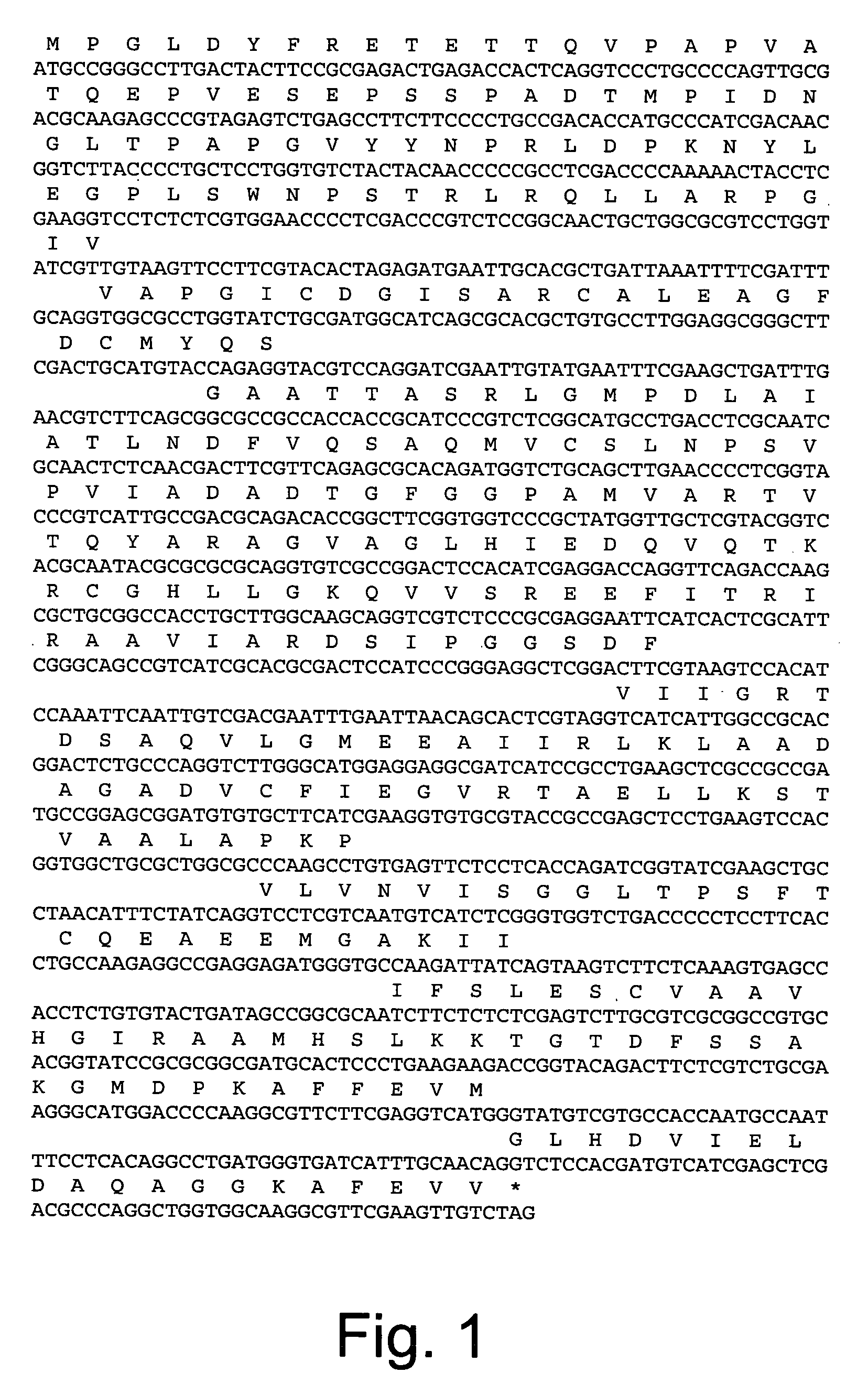Polypeptides having oxaloacetate hydrolase activity and nucleic acids encoding same
a technology of oxaloacetate hydrolase and polypeptides, which is applied in the field of isolated polypeptides having oxaloacetate hydrolase activity and isolated polynucleotides encoding the polypeptides, can solve the problems of poor degradation of lignin by most organisms, and achieves the effects of not significantly affecting the folding and/or activity of proteins, facilitating purification, and facilitating purification
- Summary
- Abstract
- Description
- Claims
- Application Information
AI Technical Summary
Benefits of technology
Problems solved by technology
Method used
Image
Examples
example 1
Isolation of Genomic DNA from Ceriporiopsis Subvermispora
[0203] A quarter inch square of agar of Ceriporiopsis subvermispora FPL 104807SS-5 (Forest Products Laboratory, Madison, Wis.) mycelia from a PDA plate was inoculated into 250 ml of YEG medium and incubated at 28° C. for 5 days. The mycelia were harvested by filtration through Miracloth (Calbiochem, San Diego, Calif.) and were frozen quickly in liquid nitrogen. Genomic DNA was isolated according to the procedure of Walheitner et al., 1996, Current Genetics 29: 395-403. The DNA pellet was resuspended in 500 μl of TE buffer (10 mM Tris-1 mM EDTA), and 5 μl was electrophoresed on a 1% agarose gel using TAE buffer (4.84 g of Tris Base, 1.14 ml of glacial acetic acid, and 2 ml of 0.5 M EDTA pH 8.0 per liter) to confirm the quality of the preparation.
example 2
Construction of a Ceriporiopsis Subvermispora Genomic Library
[0204] A total of 30 μg of Ceriporiopsis subvermispora genomic DNA was digested with Tsp509I (New England Biolabs, Beverly, Mass.) in a total volume of 150 μl using the manufacturer's recommended conditions. Aliquots of 30 μl of the digested DNA were removed at 10, 11, 12, 14, and 16 minutes after the addition of Tsp509I. The digestions were electrophoresed on a 0.8% agarose gel using TAE buffer. A gel slice containing 2 to 3 kb of digested DNA was removed, and the DNA fragments were purified using β-agarase (New England Biolabs, Beverly, Mass.) following the manufacturer's protocols.
[0205] A total of 3 μg of pUC19 was digested with EcoRI and treated with shrimp alkaline phosphatase (Amersham Pharmacia Biotech, Arlington Heights, Ill.) following the manufacturer's protocols. The digested DNA was electrophoresed on a 0.8% agarose gel using TAE buffer, and the gel slice containing the linearized plasmid was excised from th...
example 3
Isolation of RNA from Ceriporiopsis Subvermispora
[0209] Six 1 liter flasks with 29 ml of basal minimal medium were incubated with agar plugs from a PDA plate containing Ceriporiopsis subvermispora mycelia. The flasks were incubated at 28° C. without shaking for 15 days. The mycelia mats were harvested from the flasks and homogenized in sterile water in a Waring blender three times for 15 seconds with 30 second intervals to prevent the mycelia from warming. The homogenized mycelia were added to a 1 liter flask containing 20 μm of hardwood thermomechanical pulp that had previously been processed in a Waring blender for 30 seconds, and the mixture was stirred. For the minimal medium cultures, the homogenized mycelia were added to 15 ml of minimal medium in 1 liter flasks. The cultures were incubated at 30° C. for 30 days without shaking and the entire pulp culture containing pulp plus mycelia was frozen quickly in liquid nitrogen. The mycelia from the minimal medium culture were harve...
PUM
| Property | Measurement | Unit |
|---|---|---|
| Tm | aaaaa | aaaaa |
| Tm | aaaaa | aaaaa |
| Tm | aaaaa | aaaaa |
Abstract
Description
Claims
Application Information
 Login to View More
Login to View More - R&D
- Intellectual Property
- Life Sciences
- Materials
- Tech Scout
- Unparalleled Data Quality
- Higher Quality Content
- 60% Fewer Hallucinations
Browse by: Latest US Patents, China's latest patents, Technical Efficacy Thesaurus, Application Domain, Technology Topic, Popular Technical Reports.
© 2025 PatSnap. All rights reserved.Legal|Privacy policy|Modern Slavery Act Transparency Statement|Sitemap|About US| Contact US: help@patsnap.com


